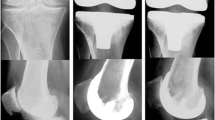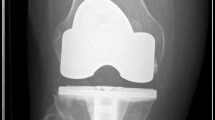Abstract
Introduction
One hundred and thirteen patients underwent the implantation of an ACADEMIA prosthesis between 1999 and 2000. The minimum follow-up period was 5 years. The ACADEMIA prosthesis is available in either uncemented or cemented model, in posterior-cruciate-retaining (PCL) and posterior-stabilised (PS) versions, with a fixed plate. This is a continuous, retrospective, multicenter study; all etiologies were included. Degenerative lesions markedly predominated; there were 106 cases of primary prosthesis. Clinical signs: They were severe with a mean total preoperative 200-point score of 74 points. The surgical procedure: Cement was used for the femoral condyle in 69 surgical procedures, for the tibial platebase in 56 cases; all patients requiring prosthetic patella had a cemented model (93 cases). Postoperative supervision: Patients were asked to undergo the clinical and radiological review required for this study. Criteria for the evaluation of osseointegration of the arthroplasty and possible radiological reactions were recorded.
Results
Postoperative complications come down to five cases of phlebitis treated with anticoagulation and two haematomas which did not require any revision procedure for surgical removal. Revision procedures: Seven patients were re-operated for various reasons. Analysis of the “200-point” overall score: The overall evaluation adding the examination score to the functional score gives an idea of the improvements obtained with the operation (74–159). Flexion and pain: The mean preoperative flexion was 107.3°; the mean postoperative flexion is 108.6°. The mean pain grade starts at 10 in the preoperative period and is 42 in the postoperative period. Mechanical axes, varus and valgus displacements: In this series, the knee showed a normal axis in 95.5% of the patients operated on while they were only 13% at the time of the preoperative examination. The HKA angles measured pre- and postoperatively confirm the correction achieved: the mean axis was at 175.2° in the preoperative period; it is at 179.6° in the postoperative period. The femoral condyle was found to be normal in all the patients reviewed, as well as the tibial or patellar implant when the latter was in place. Lucencies: Their thickness is always < 2 mm. At the femoral level, four cases of lucency are noted. At the tibial level, five cases of lucency are found. Patella: Six tilts were observed without detrimental clinical effects. Survival curve: When considering revision surgery with replacement of the prosthesis as the final indicator, the survival rate obtained is 98.23%.
Discussion
The analysis of the results according to the type of implant does not show any statistical significant difference except that complications related to the surgery were only observed in the PS series. At maximum follow-up, no breakage or failure were observed. These early results for the ACADEMIA prosthesis seem encouraging for several reasons: (1) No mechanical complication was noted in relation to the implant either in “PCL” or in “PS”. (2) Surgeons did not make any complaints or comments concerning the use of this prosthesis. (3) The clinical follow-up performed according to the 200-point score of the American Knee Society, shows a clear improvement of the performances of the patient operated on; this result is not altered by the established obesity in most patients and the great number of varus displacements detected during the preoperative evaluation. (4) The most significant improvement in the quality of life is pain relief. (5) Radiological results did not detect any deterioration of the material or significant bone modifications around the prosthesis.












Similar content being viewed by others
References
Insall J, Dorr LD, Scott RD et al (1989) Rationale of the Knee Society clinical rating system. Clin Orthop Relat Res 248:13–14
Duparc J, Massare C (1967) Mesures radiologiques des déviations angulaires du genou sur le plan frontal. Ann Radiol 10(9):635–656
Ewald FC (1989) The Knee Society TKA roëntgenographic evaluation and scoring system. Clin Orthop Relat Res 248:9–12
Cooke TDV, Scudamore RA, Bryant J, Sorbie C, Siu D, Fischer B (1991) A quantitative approach to radiography of the lower limb. Principles and applications. J Bone Joint Surg [Br] 73-B:715–720
Huguier M, Flahaut A (2003) Biostatistiques au quotidien. Elsevier, Amsterdam
Cucherat M (2004) Lecture critique et interprétation des résultats des essais cliniques pour la pratique médicale. Médecines-Sciences Flammarion
Babis GC, Trousdale MT, Pagnano MW, Morrey BF (2001) Poor outcomes of isolated tibial insert exchange and arthrolysis in the management of stiffness following total knee arthroplasty. J Bone Joint Surg [Am] 83:1534–1536
Acknowledgments
Conflict of Interest
The author(s) has/have received or will receive benefits for personal or professional use from a commercial party related indirectly to the subject of this manuscript.
Author information
Authors and Affiliations
Consortia
Corresponding author
Additional information
AGREG is a Group belonging to GECO (Groupe d’Etude pour la Chirurgie Osseuse, 24. rue de la Sinne, BP 1232, 68054, Mulhouse Cedex, France).
Le Groupe d’Etude de la Chirurgie Osseuse (“GECO”) (Bone Surgery Study Group) further extended its audience and areas of competence integrating separate research groups that had been involved for several years in designing and develo** some advanced techniques in the surgical field and training practitioners and their teams to these techniques.
AGREG (Groupe de recherche et d’étude sur le genou) (Research and Study Group for Knee Surgery) initiated the evaluation of knee prostheses.
Rights and permissions
About this article
Cite this article
Philippe, M., Petit, R. & AGREG Group. Results of a series of 113 ACADEMIA total knee prostheses with a follow-up at 5 years. Eur J Orthop Surg Traumatol 18, 269–278 (2008). https://doi.org/10.1007/s00590-008-0298-5
Received:
Accepted:
Published:
Issue Date:
DOI: https://doi.org/10.1007/s00590-008-0298-5




